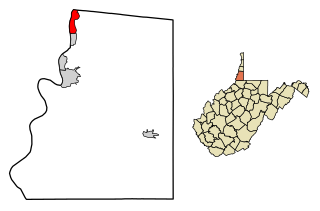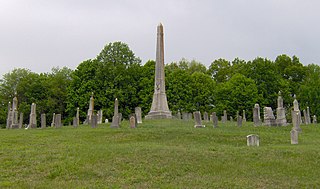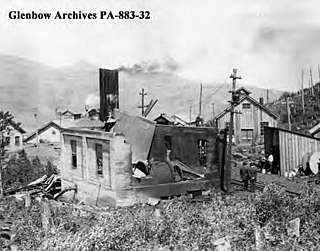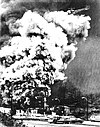Related Research Articles

Benwood is a city in Marshall County, West Virginia, United States, along the Ohio River. It is part of the Wheeling, West Virginia Metropolitan Statistical Area. The population was 1,269 at the 2020 census.
A mining accident is an accident that occurs during the process of mining minerals or metals. Thousands of miners die from mining accidents each year, especially from underground coal mining, although accidents also occur in hard rock mining. Coal mining is considered much more hazardous than hard rock mining due to flat-lying rock strata, generally incompetent rock, the presence of methane gas, and coal dust. Most of the deaths these days occur in developing countries, and rural parts of developed countries where safety measures are not practiced as fully. A mining disaster is an incident where there are five or more fatalities.

The Fraterville Mine disaster was a coal mine explosion that occurred on May 19, 1902 near the community of Fraterville, in the U.S. state of Tennessee. Official records state that 216 miners died as a result of the explosion, from either its initial blast or from the after-effects, making it the worst mining disaster in the United States' history, and remains the worst disaster in the history of Tennessee. However, locals claim that the true number of deaths is greater than this because many miners were unregistered and multiple bodies were not identified. The cause of the explosion was likely ignition of methane gas which had built up after leaking from an adjacent unventilated mine.

Massey Energy Company was a coal extractor in the United States with substantial operations in West Virginia, Kentucky and Virginia. By revenue, it was the fourth largest producer of coal in the United States and the largest coal producer in Central Appalachia. By coal production weight, it was the sixth largest producer of coal in the United States.

The Monongah mining disaster was a coal mine explosion on December 6, 1907, at Fairmont Coal Company's Nos. 6 and 8 mines in Monongah, West Virginia, which killed 362 miners. It has been described as "the worst mining disaster in American history" and was one of the contributing events that led to the creation of the United States Bureau of Mines.

The Sago Mine disaster was a coal mine explosion on January 2, 2006, at the Sago Mine in Sago, West Virginia, United States, near the Upshur County seat of Buckhannon. The blast and collapse trapped 13 miners for nearly two days; only one survived. It was the worst mining disaster in the United States since the Jim Walter Resources Mine disaster in Alabama on September 23, 2001, and the worst disaster in West Virginia since the 1968 Farmington Mine disaster. It was exceeded four years later by the Upper Big Branch Mine disaster, also a coal mine explosion in West Virginia, which killed 29 miners in April 2010.

The Farmington Mine disaster was an explosion that happened at approximately 5:30 a.m. on November 20, 1968, at the Consol No. 9 coal mine north of Farmington and Mannington, West Virginia, United States.
Bartley is a census-designated place (CDP) located in McDowell County, West Virginia, United States. It lies along the Norfolk and Western Railroad on the Dry Fork. As of the 2010 census, its population was 224. According to the Geographic Names Information System, Bartley has also been known as Bartlett and Peeryville.

The Hillcrest mine disaster, the worst coal mining disaster in Canadian history, occurred at Hillcrest, Alberta, in the Crowsnest Pass region, on June 19, 1914, 9:30 am.

Shepherd Hall, also known as Monument Place and formerly as Stone Mansion, is a historic house listed on the National Register of Historic Places in the city of Wheeling in the U.S. state of West Virginia. It is located in the Elm Grove area of Wheeling, Ohio County, West Virginia.
Father Everett Francis Briggs, MM was a Catholic priest and miners' activist who served as a member of the Maryknoll society.
Bishop Donahue Memorial High School was a private, Roman Catholic high school in McMechen, West Virginia. It was part of the Roman Catholic Diocese of Wheeling-Charleston. It was named after Bishop Patrick James Donahue (1849–1922), who served as the third Bishop of the Diocese of Wheeling from 1894 until his death in 1922.

The Darr Mine disaster at Van Meter, Rostraver Township, Westmoreland County, Pennsylvania, near Smithton, killed 239 men and boys on December 19, 1907. It ranks as the worst coal mining disaster in Pennsylvanian history. Many victims were of immigrants from central Europe, including Rusyns, Hungarians, Austrians, Germans, Poles and Italians.

The Cross Mountain Mine disaster was a coal mine explosion that occurred on December 9, 1911, near the community of Briceville, Tennessee, in the southeastern United States. In spite of a well-organized rescue effort led by the newly created Bureau of Mines, 84 miners died in the disaster. The cause of the explosion was the ignition of dust and methane gas released by a roof fall. Miners would use open oil lamps to provide a light source down in the mines.
Two separate explosions in 1903 and 1908 at Hanna Mines, coal mines located in Carbon County, Wyoming, United States, caused a total of over 200 fatalities. The 1903 incident was Wyoming's worst coal mining disaster.
The panhandle coalfield is a coalfield located in the northern panhandle of West Virginia counties of Hancock, Brooke, Ohio, Marshall, and Wetzel. Mining is primarily in the Pittsburgh coal seam, sometimes called the No. 8 seam, which is of a steam rather than metallurgical nature in this region. Currently CONSOL Energy maintains two large mines in this field - Shoemaker and McElroy. Also, the first new mine in Ohio County in forty years was being developed on Short Creek by Alliance Coal Co. in 2009.

The Upper Big Branch Mine disaster occurred on April 5, 2010 roughly 1,000 feet (300 m) underground in Raleigh County, West Virginia at Massey Energy's Upper Big Branch coal mine located in Montcoal. Twenty-nine out of thirty-one miners at the site were killed. The coal dust explosion occurred at 3:27 pm. The accident was the worst in the United States since 1970, when 38 miners were killed at Finley Coal Company's No. 15 and 16 mines in Hyden, Kentucky. A state funded independent investigation later found Massey Energy directly responsible for the blast.

The Eccles mine disaster was an explosion of coal-seam methane that took place on April 28, 1914, in Eccles, West Virginia. The explosion took the lives of at least 180 men and boys.

The Mammoth Mine disaster or Frick Mine explosion occurred on January 27, 1891 just after 9:00 AM in the Mammoth No. 1 mine in Mount Pleasant Township, Westmoreland County, Pennsylvania. Newspapers reported that firedamp was ignited by a miner's oil lamp, resulting in the deaths of 109 men and boys. Most of the miners were not killed by the force of the explosion, but rather were suffocated by the effects of afterdamp.
J. Davitt McAteer is an American lawyer, author, and activist from Fairmont, West Virginia. McAteer was appointed to the position of assistant secretary for the Mine Safety and Health Administration from 1993 to 2000 under President Bill Clinton. Throughout his career, McAteer has been an advocate for safe working conditions for miners, particularly in the coal industry. After the Upper Big Branch Mine disaster of 2010, where an explosion caused by negligence led to the death of 29 miners, McAteer Served on Governor Earl Ray Tomblin's independent investigation panel to determine the cause of the explosion. McAteer is the author of "Monongah: The Tragic Story of the 1907 Monongah Mine Disaster".
References
- 1 2 3 4 "On This Day in West Virginia History" . Retrieved 2023-10-09.
- ↑ "WV Mine Disasters 1884 to Present". Archived from the original on 2012-03-10. Retrieved 2012-05-21.
- ↑ "Benwood Mine Explosion". Archived from the original on 2010-12-03. Retrieved 2012-05-18.
- ↑ "Benwood Mine Disaster" . Retrieved 2012-05-18.
- ↑ "Community Gathers to Remember Lives Lost in Mining Disaster" . Retrieved 2019-09-10.
- ↑ "Community Leader Remembered at Benwood Mine Memorial" . Retrieved 2019-09-10.
